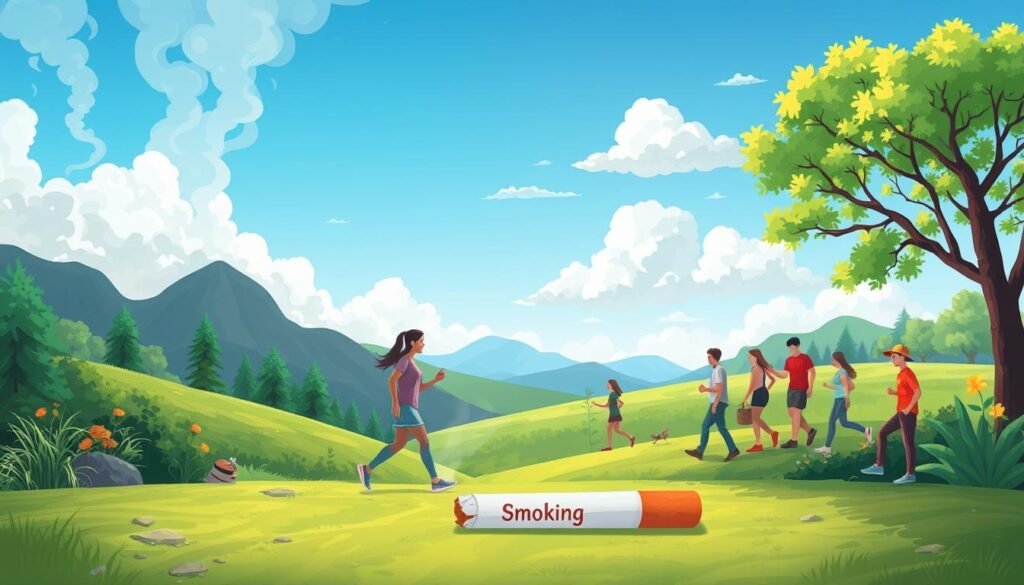Did you know cigarette smoking causes up to 90% of lung cancers? This fact shows the strong link between smoking and lung cancer. The concept of pack years combines the number of cigarettes and years someone has smoked. It helps predict the chance of getting lung cancer. In the U.S., lung cancer is the top cause of cancer deaths, mainly due to smoking. We’ll look into studies that explain how smoking affects health and policy.
Key Takeaways
- Pack years measure smoking exposure and increase lung cancer risk proportionally.
- Male smokers may require more pack years than females to develop lung cancer.
- The earlier someone begins smoking, the greater their lung cancer risk.
- Quitting smoking reduces heart disease risk, but lung cancer risk remains elevated for years.
- Current and former smokers with significant pack years should undergo lung cancer screenings.
Understanding Pack Years
Pack years measure how much a person has smoked over time. They show health risks from smoking. Knowing about pack years helps understand smoking’s effects.
Definition and Calculation of Pack Years
The pack years definition is simple. It multiplies daily cigarette packs by smoking years. For instance, if you smoke a pack a day for 20 years, you have 20 pack years. This helps doctors see how much and how long you’ve smoked.
Importance of Pack Years in Assessing Health Risks
Pack years are key in spotting health risks. More pack years can mean higher chances of lung cancer and heart disease. Longer smoking times usually raise risks more than smoking more cigarettes in a shorter time.
How Pack Years Correlate with Lung Cancer Probability
The link between pack years of smoking and the chance of getting lung cancer is clear. Studies have shown how important both the amount and length of smoking are. They help measure health risks, suggest ways to avoid them, and find the disease early.
Research Findings on Smoking Intensity
How much you smoke is key in determining lung cancer risk. A study in the Journal of Clinical Oncology showed a gap in risk calculations. Smokers of a pack a day for 20 years are not the only ones at risk. Those who smoke less but for longer also have a high risk. This means we need to better understand smoking habits to gauge lung cancer risk accurately.
Effects of Smoking Duration on Lung Cancer Risks
Smoking for a long time ups your chance of lung cancer, even if you quit. Long-time smokers still face high risks, research says. Their lung cancer risk stays high even 25 years after they stop smoking. This highlights why even former smokers need regular lung health checks. They’ve been exposed to harmful substances for years, which can lead to cancer.
The importance of how much and how long you’ve smoked is clear. These factors must be considered when evaluating lung cancer risk. They guide tailored health advice. For more on smoking and cancer, check out tobacco research.
The Role of Smoking History in Lung Cancer
Smoking history plays a big role in lung cancer. It shows big differences between those who smoke now and those who stopped. Knowing these differences helps us work on lowering lung cancer rates.
Differences Between Current and Former Smokers
Currently, smokers get lung cancer more often, at a rate of 1.97 per 1000 people each year. This rate drops to 1.61 for those who have quit. Even after quitting, the risk remains three times higher than for non-smokers. Heavier smokers who’ve quit still face a big risk for many years. This shows how vital it is to quit smoking early.
Impact of Secondhand Smoke
Secondhand smoke also raises lung cancer risk in non-smokers by 20-30%. This fact underlines the need for strong public health efforts to cut down tobacco exposure. With 1.69 million people dying each year from smoking-related causes, the issue is serious. In the U.S., cigarette smoking causes 87% of lung cancer deaths.
| Smoking Status | Incidence Rate (per 1000 person-years) | Relative Risk of Lung Cancer |
|---|---|---|
| Current Smokers | 1.97 | 1.0 (baseline) |
| Former Smokers | 1.61 | 3.85 – 12.12 (varies) |
| Never Smokers | 0.26 | 0 |
Carcinogenic Exposure and Lung Cancer
The link between cigarette carcinogens and lung cancer is clear. Cigarettes have over 7,000 chemicals. At least 70 are cancer-causing. Benzene, formaldehyde, and radioactive polonium-210 are some key culprits. Because of these, the risk of lung cancer goes up, showing how bad tobacco smoke is for our health.
Types of Carcinogens Present in Cigarettes
Cigarettes are a major source of various carcinogens. These include:
- Polycyclic aromatic hydrocarbons (PAHs)
- Nitrosamines
- Heavy metals like cadmium and arsenic
- Aromatic amines
This makes smoking a huge health issue worldwide. Understanding these components is key. It shows us how tobacco leads to serious lung diseases.
Long-Term Effects of Exposure on Health
Being around these carcinogens for a long time can cause many health problems. Research shows they can lead to diseases like COPD and various cancers. Even those who’ve quit smoking can be at risk. Their lung function could be affected for years. A shocking fact: lung cancer risk goes up by 45% if cadmium levels rise. This shows the lasting impact of smoking and the need for strong quitting support.
| Carcinogen | Type | Health Risks |
|---|---|---|
| Benzene | Hydrocarbon | Blood cancers, including leukemia |
| Formaldehyde | Gas | Nasal and throat cancers |
| Cadmium | Heavy metal | Lung cancer |
| Polonium-210 | Radioactive element | Direct lung damage, cancer promotion |
It’s critical to fight the health risks from tobacco. People need to know these facts to protect themselves and others.
Lung Cancer Screening Guidelines
Lung cancer screening is key for early catching and helping save lives, mainly for those at high risk. The current guidelines suggest a yearly low-dose CT scan for people 50 to 80 years old who have smoked a lot. If you’ve smoked for 20 pack-years or just quit in the last 15 years, you should get checked every year. This shows how important it is to look after our health early on.
Current Recommendations for Lung Cancer Screening
Different groups, like the U.S. Preventive Services Task Force, lay out key points for lung cancer checks:
- People 55 to 77, with over 30 pack-years of smoking, should get a yearly low-dose CT scan. This counts whether they still smoke or quit up to 15 years ago.
- Those 50 to 80 years old and with at least 20 pack-years of smoking should also get checked every year, though it’s a softer push.
- If you’ve smoked less than 20 pack-years, are younger than 50, older than 80, or quit smoking more than 15 years ago, screening isn’t recommended.
- Screening doesn’t make sense for those with serious health issues that affect their life span or how they’d handle treatment.
Limitations of Existing Guidelines
The guidelines aren’t perfect and have some big gaps. For instance, people who stopped smoking over 15 years ago but smoked a lot before might not qualify for screening. This could leave some lung cancers undetected. Plus, the rules might not fully consider how smoking rates differ across racial and ethnic lines. This can create more chances for some people to slip through the cracks in our health system.
| Age Group | Pack-Year History | Screening Recommendation |
|---|---|---|
| 55-77 | 30 or more | Annual Low-Dose CT (Strong Recommendation) |
| 50-80 | 20 or more | Annual Low-Dose CT (Weak Recommendation) |
| Under 50 / Over 80 | Less than 20 | No Screening Recommended |
| Severe Comorbidities | Any History | No Screening Recommended |
Quitting Smoking and its Benefits
Quitting smoking can lead to huge improvements in health. One major benefit is a lower risk of lung cancer. Stopping smoking greatly reduces this risk.
People who quit by age 45 may cut their risk of dying from lung cancer by 87%. Quitting by 35 years old can remove the added risk of lung cancer death. Even those who stop between 55 and 64 years can cut their risk by more than half. These facts can motivate smokers to quit.
How Lung Cancer Risks Change After Quitting
The health benefits of quitting smoking are massive. Those who never smoked have a much lower chance of getting lung cancer than those who smoke their whole lives. Quitting does lower the risk, but early smokers still face challenges.
Starting young greatly increases the danger. Smoking before age 10 makes the risk of dying from cancer four times higher. Starting before 18 triples the cancer death risk. But quitting has benefits that go beyond just health right now.
Factors Influencing Successful Quitting
Many things affect the success of quitting smoking. Support from family, friends, or programs is key. Tools like counseling and nicotine replacements help too.
Public health campaigns offer resources and raise awareness. They make it easier to find help for quitting. These supports can increase the chance of quitting for good and lower lung cancer risks.

| Age at Quitting | Risk Reduction |
|---|---|
| Before Age 35 | Eliminates excess risk of dying from lung cancer |
| By Age 45 | 87% lower risk of death from lung cancer |
| Between Ages 55-64 | Over 50% reduction in lung cancer mortality risk |
Public Health Campaigns and Awareness
Public health campaigns are key to changing how people think and act about smoking. They teach about the dangers of tobacco and how it leads to lung cancer. These programs are crucial to cut down smoking rates and make a healthier society.
Importance of Education on Smoking Risks
Teaching the public about the dangers of smoking is crucial. Such education can change old habits and ideas about tobacco. Through well-aimed campaigns, important facts about smoking’s risks and lung cancer are shared. This makes people think twice about their choices.
Impact of Campaigns on Smoking Rates
Studies prove that public health campaigns really help lower smoking. Teaching about lung cancer risks has led to less smoking in many places. Using various media strategies, these campaigns fill in the knowledge gaps. They challenge existing norms about smoking, leading to better lung health for everyone.
| Country | Current Smoking Rate | Impact of Recent Campaigns |
|---|---|---|
| United States | 12.5% | Decreased by 25% in the last 5 years |
| Canada | 13.0% | Decreased by 20% in recent years |
| Japan | 17.0% | Minimal decrease, awareness programs ongoing |
| South Korea | 23.1% | Decreased by 15% due to strong campaigns |
Future Research Directions
There are lots of chances to learn more about lung cancer in the future. It’s important to look at all the details – like how smoking and genes affect lung cancer. We should really focus on long studies with different kinds of people. This will help make public health better and create good screening rules.
Need for Comprehensive Studies on Lung Cancer
Lung cancer isn’t just in smokers anymore. Now, 10–25% of lung cancers are in people who’ve never smoked. We need to dig deeper into studies to understand these cases better. This will help us learn how different smoking habits affect different people. Then we can find better ways to prevent and treat lung cancer.
Understanding Gender Differences in Smoking Effects
Recent findings show that lung cancer affects women differently than men, even if they smoke less. It’s crucial to figure out how smoking impacts men and women in diverse ways. This info can help us help people more, especially young women around secondhand smoke. By keeping up this research, we can make health messages and programs that really speak to people. Check out this valuable resource for more on lung cancer studies.

Comparing the Impact of Different Smoking Patterns
Studying how different smoking habits affect lung cancer risk is important. Heavy and light smokers face different health issues. This knowledge helps create better public health policies.
Heavy Smokers vs Light Smokers
Heavy smokers smoke a lot of cigarettes every day and have a higher lung cancer risk. They usually have more pack years, which means higher death rates. When diagnosed, they often have more severe lung cancer.
Light smokers, while smoking less, also face health risks. Recent studies show they can get lung cancer too. It’s important to see light smoking as a big risk too.
Duration of Smoking vs Intensity of Smoking
The length of time someone smokes is often more risky than how much they smoke. Being exposed to smoke for years is a big cancer risk. Even light smokers are at risk if they smoke for a long time.
This makes it tough to compare lung cancer risks. People who smoke for many years have big risks. Changing how we look at risks could help catch cancer early.
| Smoking Pattern | Daily Cigarettes | Pack Years | Lung Cancer Risk |
|---|---|---|---|
| Heavy Smokers | More than 20 | 30+ | High |
| Light Smokers | 1-10 | 1-29 | Moderate |
Ethnic Disparities in Lung Cancer Risk
It’s vital to understand how smoking affects different ethnic groups to tackle lung cancer risk. Studies show big differences in demographic smoking habits between African Americans and Europeans. These habits affect not just when people start smoking and how often but also lung cancer rates.
Variations in Smoking Habits Across Different Demographics
African Americans face a 32% higher lung cancer rate than Europeans. They usually start smoking later and smoke less often. Despite smoking fewer cigarettes, their preference for menthol cigarettes significantly affects smoking behavior and quitting success. A whopping 85% of African American smokers prefer menthols, against 20-30% of European American smokers.

Addressing Racial Disparities in Lung Cancer Outcomes
Racial differences in lung cancer rates are clear, even for those who’ve never smoked. Barriers in healthcare delay diagnosis and treatment for African Americans. Plus, there’s limited research on lung cancer screening for Black and low-income people. This leads to poor screening and care access, worsening lung cancer outcomes.
To achieve health equality, we need targeted public health efforts and better education on screening and treatment. Understanding the specific challenges and behaviors of different ethnic groups helps. This way, we can create health initiatives that lower the racial gaps in lung cancer.
Preventive Measures for Lung Cancer
Preventive health is key to lowering lung cancer risk. Regular check-ups help catch lung cancer early, especially in smokers or those exposed to risks. These visits let doctors watch your lung health closely. They recommend screenings and start early treatments. Finding problems early can save lives.
Importance of Regular Health Check-Ups
Screenings and doctor visits are crucial for those at risk. Regular check-ups can spot lung cancer early when it’s easier to treat. It’s very important for smokers or those exposed to carcinogens to get yearly lung screenings.
Emphasis on Lung Cancer Awareness Programs
Lung cancer awareness programs boost public health efforts. They teach about lung cancer’s importance, detection, and smoking’s dangers. By making people aware, these programs help smokers make better health choices. They encourage everyone to get regular check-ups as a preventive step.
Conclusion
Understanding pack years is vital for assessing lung cancer risk. It shows the strong connection between smoking and lung cancer. Research tells us that eight out of ten lung cancer deaths link to smoking. This shows why we must push for more people to stop smoking.
The rise in lung cancer cases among non-smokers calls for more research. Studies from the American Cancer Society and the CDC highlight this need. They show we must support those affected and keep researching.
Health campaigns now must cover more than just smoking. They should talk about secondhand smoke and things like radon exposure. This approach can lower lung cancer rates. It will help keep people healthier.
It’s clear: focusing on risk assessment and quitting smoking is key. It can lead to big improvements in dealing with lung cancer. By working together on education and support for quitting, we can create a healthier future. A future where lung cancer’s impact is greatly reduced.